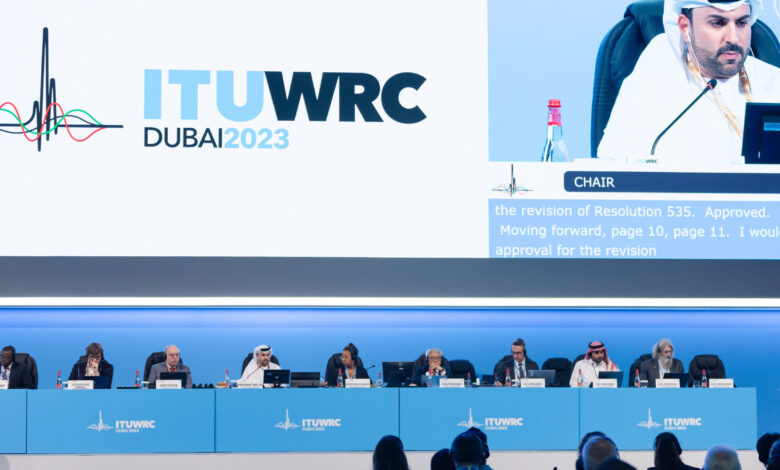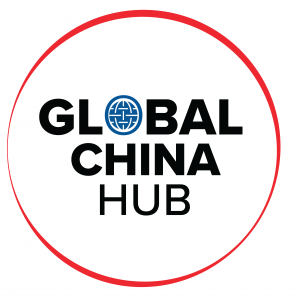Digesting the 2023 World Radiocommunication Conference’s outcomes and implications for US-China 5G competition

April 12, 2024 • 12:00 pm ET
Digesting the 2023 World Radiocommunication Conference’s outcomes and implications for US-China 5G competition
TO: Security and technology community of the United States, its allies, and partners
FROM: Ngor Luong
DATE: April 12, 2024
SUBJECT: Digesting the 2023 World Radiocommunication Conference’s outcomes and implications for US-China 5G competition
In February 2024, the Atlantic Council’s Global China Hub convened a group of policy and industry experts for a private workshop to examine the outcomes of the 2023 World Radiocommunication Conference (WRC) held in Dubai from November 20 to December 15, 2023, as well as to discuss China’s ambitions for leadership in 5G technology and its economic and security implications for the United States, its allies, and partners. This memorandum captures key insights from the workshop.
Strategic context
As the fifth generation of mobile and cellular networks, 5G is a disruptive technology crucial for enhancing digital connectivity for better efficiency and productivity in the commercial economy and the military. Increased wireless connectivity can support various industries and sectors, including autonomous vehicles, advanced robotics, and smart agriculture, among others. Moreover, such connectivity can improve intelligence, surveillance, and reconnaissance (ISR) systems and streamline command and control in military operations. Given these benefits of 5G, both the United States and China have sought to achieve global leadership on this technology. A country that can fully roll out a nationwide 5G network can reap the benefits of the technology domestically and lead in international standard-setting.
The development and deployment of 5G or next generations of wireless technology not only requires the construction of new infrastructure, but also a significant allocation of the finite radiofrequency spectrum. Allocating sufficient amounts of spectrum for domestic 5G networks is critical to the success of those networks and to the ability to lead the development of innovations across industries and sectors. 5G networks can be deployed in multiple ranges of frequency bands from low, mid, to high with varying degree of coverage and speed. Low-band spectrum (less than 1 GHz) offers great coverage but lacks the bandwidth to accommodate transfer of huge amounts of data, while high-band frequencies (millimeter wave bands above 24 GHz) support the fastest broadband speed over shorter distances. Mid-band spectrum (1-24 GHz) offers a mixture of coverage and speed, making it most suitable for 5G use in urban and rural areas. In the context of 5G deployment, the lower mid-band (3-8.4 GHz) largely offers more balance between speed and coverage than the upper mid-band (8.4-24 GHz).
Chinese telecommunications companies like Huawei and ZTE deploy 5G using sub-6 GHz mid-band spectrum that suits its network infrastructure. In 2023, China allocated spectrum in the 6 GHz band for International Mobile Telecommunications (IMT). For its part, the US has made greater amounts of high-band spectrum, with the Federal Communications Commission (FCC) auctioning this band more than other flexible use bands combined. The more suitable bands for 5G are lower mid-band and low-bands available in the country, some of which the FCC has made available. Meanwhile, 6 GHz is kept for incumbent licensed operators operating in these bands, such as satellite operators and government services, who are concerned with the potential for harmful interference, or the prospect of relocating to another band. The success of 5G deployment hinges on efficient spectrum allocation domestically and harmonization internationally to ensure interoperability across different countries.
The outcome of the WRC23
Between November and December 2023, the International Telecommunication Union (ITU) convened 163 nations at the quadrennial WRC in Dubai to manage cross-border radio frequency spectrum usage, ensuring equal access and preventing interference. The WRC identified parts of the 6 GHz band for IMT applications and identified IMT bands above 7.125 GHz for future study. The US delegation to the WRC successfully protected US interests concerning 6 GHz IMT by keeping it unlicensed under ITU regulations in its region. China, on the other hand, has advocated at the WRC23 for the harmonization of this band for 5G use to advance its companies’ position in the global market for 5G. A global harmonization of 6 GHz has two implications for the US. First, with 6 GHz currently kept for unlicensed use, the US may have less mid-band spectrum available than other countries like China that allocate 6 GHz for commercial uses. Second, there would be a greater demand for 5G equipment compatible with 6 GHz for commercial uses than equipment for unlicensed technologies.
Although the United States successfully demonstrated its spectrum policy priorities at the WRC, workshop participants agreed it should create a more forward-looking agenda to achieve spectrum harmonization with other nations. With the WRC convening every four years, it’s crucial that the United States maintains the momentum with its allies and partners to devise strategies that safeguard domestic interests while also countering China’s global influence in spectrum policy.
China’s domestic support and international outreach for 5G
According to its 14th Five-Year Plan (2021-2025), China aims to build a modern infrastructure system, including by accelerating the deployment of 5G networks and developing the technology for future deployment of 6G. As such, Chinese telecommunication operators are accelerating domestic 5G deployment, having built 3.2 million 5G base stations in China by September 2023, a nearly 250 percent increase from the 916,000 base stations in July 2021.
The Chinese government supports its national champions politically and financially. Government subsidies in part propelled Huawei forward as a leader in the 5G space, for instance, allowing it to secure 10 percent of the global mobile wireless market by the mid-2000s. China has also taken a proactive approach to spectrum allocation that involves industry and military actors, as delineated in its Radio Management Regulations released by the State Council and the Central Military Commission. The government has opted for a mid-band spectrum allocation, which is considered ideal for 5G deployment, as it offers the best compromise between speed and coverage.
The Chinese government also supports its telecom providers with export financing loans to help them reach the international market. China’s state banks offer loans to other nations in exchange for an agreement to purchase Huawei’s equipment. Meanwhile, as laid out in the China Standards 2035 plan, China has encouraged its firms to increase their influence in international standard-setting organizations, including to shape how spectrum is released.
Workshop participants expressed concerns about China’s ambitions to dominate in 5G. There are concerns about China’s efforts to seek global spectrum harmonization that is in favor of its telecom providers, in particular on 6 GHz. Additionally, with state-backed loans, Huawei has already reached the hardware market in the Group of Seventy-Seven (G77) countries. While Huawei has earned a good reputation as a one-stop shop for many network and telecom providers, there are concerns regarding cyber vulnerability in the telecom and cloud infrastructure. Workshop participants also noted that China’s slow economic growth may hinder its ability to continue offering below-market rate credits.
Implications for the United States, its allies, and partners
There is a window of opportunity for the United States, its allies, and partners to grapple with the challenges posed by China’s quest for 5G leadership. The United States will need to leverage existing tools and ramp up bilateral and multilateral coordination with its allies and partners.
The United States has its own tools to counter China’s international reach in 5G. Domestically, the FCC’s rip and replace program was set to remove Chinese information and communication technology products from US networks, but it currently faces a $3 billion gap in funding. Meanwhile, the National Spectrum Strategy identified the 7-8 GHz mid-band as one spectrum band that merits further in-depth study to identify spectrum availability and opportunity for private use. This effort may address the disparity in the availability of the 6 GHz mid-band spectrum between the US and the rest of the world due to the US preference to keep 6 GHz band unlicensed. There is evidence that 7-8 GHz, which sits adjacent to 6 GHz and can participate in the same “tuning range,” provides comparable benefits. Workshop participants noted that it is important for the United States to conduct these studies and coordinate early with other countries to lead on the 7-8 GHz band ahead of the next WRC. Crafting domestic policies on both equipment and spectrum policy for 5G is an important first step to clarify US priories and promote information sharing with allies and partners for better coordination.
US national interests in spectrum harmonization underscore the importance of aligning these interests with US allies and partners’ interests. The competition for 5G leadership includes countries beyond the United States and China. Several key actors, including those in Europe, also have an interest in opening the 6 GHz band that China advocated for at the WRC23. While the government of India has yet to identify the 6 GHz spectrum for its 5G expansion, a major Indian mobile carrier has already advocated for it. For its part, the United States must move quickly to coordinate with key allies and partners to avoid developing 5G in isolation.
Beyond bilateral engagements, it is imperative for the United States to also align its national advocacy with that of other countries in the region. Collaboration on strategic technologies like 5G has taken center stage for the Quad—a strategic security dialogue that includes the United States, Japan, Australia, and India. One of the Quad’s priorities is to ensure that “regional countries are not left behind as telecommunications markets and network architectures evolve.” In South America and Africa, the 5G discussion often revolves around equipment, but countries in these regions have begun the process of improving their spectrum allocation.
The United States needs to better integrate perspectives from other regions to craft a compatible 5G road map, reap the benefits of the technology, and maintain its leadership in this space.
About the author
Ngor Luong is a nonresident fellow in the Atlantic Council’s Global China Hub. Luong is also a senior research analyst at Georgetown University’s Center for Security and Emerging Technology, where she focuses on China’s science and technology ecosystem, artificial intelligence investment trends, and artificial intelligence diplomacy in the Indo-Pacific region. Previously, Luong worked at the Center for American Progress, where she researched China’s industrial policy and 5G.

Global China Hub
The Global China Hub researches and devises allied solutions to the global challenges posed by China’s rise, leveraging and amplifying the Atlantic Council’s work on China across its fifteen other programs and centers.
Image: ITU World Radiocommunication Conference 2023 (WRC-23) ©ITU/C.Chacko



